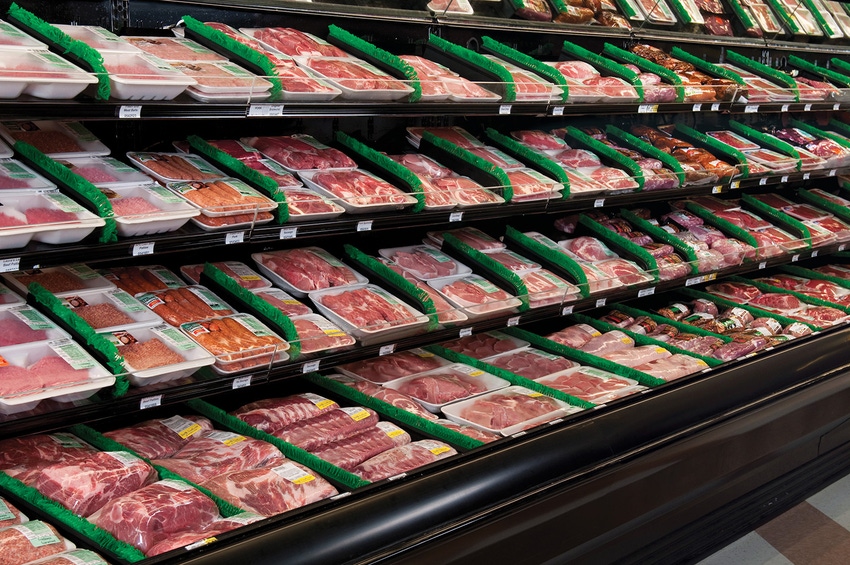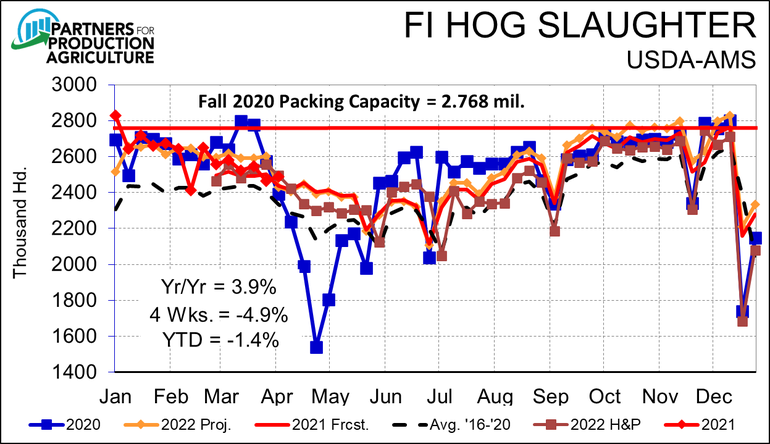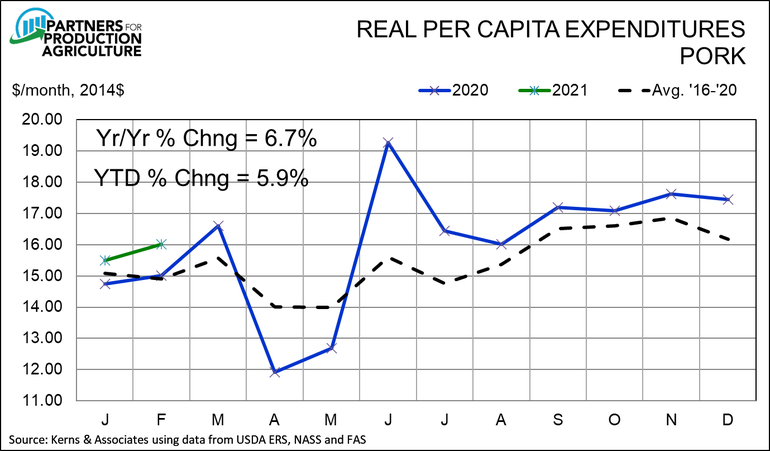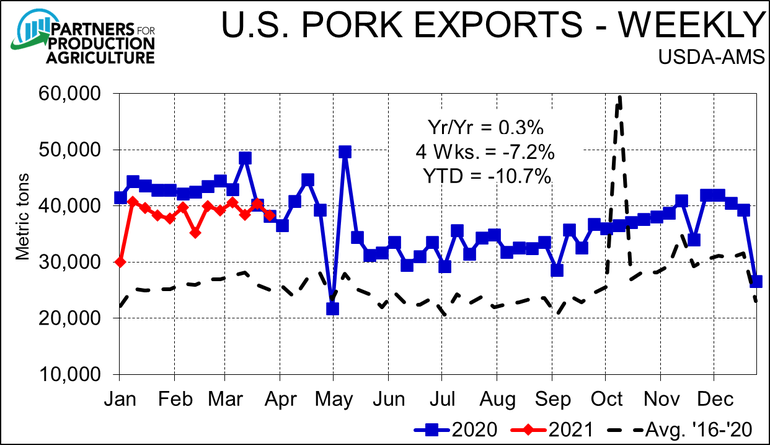Demand key factor driving markets
Strong domestic demand and exports continue to boost markets.
April 12, 2021

A famous adage of Bill Clinton’s presidential campaign in 1992 was, “It’s the economy, stupid!” I won’t completely paraphrase that because I don’t think any of our readers are stupid, but I would characterize the pork and hog markets as, “It’s the demand!”
Since March 1, slaughter rates have been, except for the week of March 26, higher than I expected. They have also been slightly larger than USDA’s March “Hogs and Pigs” report would have suggested, using actual March 1, 2021 inventories compared to those of 2019 and weekly slaughter in 2019. The reason for that comparison, of course, was that COVID-related weekly slaughter distortions began in March 2020 when consumers bought up every piece of meat in sight at grocery stores and packers had to run full out in a futile effort to restock the shelves.
Anyone interested in facts can see in Figure 1 that this year’s slaughter ran well ahead of 2020 the first two weeks of the year, and then ran even with last year’s large levels—except for one weather-driven week in February—before we hit the 2020 early COVID-driven surge in March. Nothing will be comparable to one year ago from here until September but note that slaughter forecasts based on USDA inventories stay above the five-year average except for July and August. My forecasts stay above the five-year average all the way through the end of the year.

The main implication: slaughter levels will remain strong—not overwhelming, but certainly large from a historical perspective.
And we shouldn’t really care at this point, because demand is the key factor driving pork and hog markets. And it has been the factor driving these markets all year.
Figure 2 shows monthly data for real per capita expenditures (RPCE) for pork. RPCE is a reasonable measure of the strength of demand as it is determined by the real (ie. deflated) retail price of pork and per capita pork consumption. Price and quantity constitute demand, not just quantity. Those two components are negatively related, so their product will indicate whether one is compensating for the other. Higher RPCE means higher demand.

Last week’s February export data provided all of the needed information from which to compute February per capita pork consumption and, thus, RPCE. The news was great with RPCE exceeding the year-ago level by 6.7%. When combined with January’s 4.8% increase, year-to-date RPCE is now up nearly 6% from one year ago.
While RPCE tells us the status of demand, it does not tell us just why it changes. The best we can do is consider the factors that impact demand and what may be influencing them at present.
Income levels. Higher incomes allow consumers to buy more of everything, perhaps, or at least more of those things they really want. While COVID-19 had a significantly negative impact on the economy, federal stimulus payments in 2020 kept money in consumers’ pockets, and it appears they spent some of it on meat. Total RPCE for beef, pork and chicken was up 6.9% in 2020. This year’s stimulus payments are just now being spent, so I think this will be a positive again in 2021.
Prices of competitor goods. Higher prices for products for which pork can be substituted will push pork demand higher. Real beef prices were 8.3% higher last year and are up 4.5% so far in 2021. Real chicken prices were 4.9% higher in 2020 and are up 5.5% so far this year.
Consumer tastes and preferences. This is the “black box” of demand analysis. Having money to spend and comparing the price of alternative goods are important, but the real thing that drives consumers is what they like, regardless of the reason. Changing what consumers like in favor of pork has been the mission of producers’ hard-earned checkoff dollars since back in the ‘60s. During the ‘80s and ‘90s, holding our own was likely as good as we could do against the onslaught of what has proven to be fat and cholesterol mythology and a rapidly growing broiler sector. Since then, some gains have been made.
Shift from foodservice to retail
The changes in 2020 and 2021 have had another driver that, I suppose, falls into the tastes and preferences area but has competitor pricing aspects as well. This driver has been the massive shift from foodservice to retail due to COVID-19 restrictions. Our first inclination was that demand was going to take a huge hit when restaurants, QSRs and other outlets began shutting last year. But we all forgot that people were still going to eat. Consumers began buying more food for at-home consumption and pork fared well. Before COVID, where could a consumer more easily buy a piece of pork– in a restaurant that barely included pork on any non-breakfast menu or in a grocery store? The latter. Since pork was hardly on restaurant menus other than for breakfast, where could consumers make a better direct comparison of the relative value of pork, beef, chicken, and turkey? Grocery stores win again.
It is clear now that demand simply shifted, raising this year’s million-dollar question: What happens when the restaurants re-open? Pork (and meat) demand may wane a bit as consumers buy meat one serving at a time instead of one package at a time. A given number of dollars will simply buy less tonnage in a restaurant. But the magnitude of the pork gains in January and February suggests some staying power from consumers actually cooking, some of them discovering they like to cook and the pretty obvious result that pork has been a big part of that shift.
Exports remain strong
And then there is the export market. It is a bit of a tough sell to say that exports have been strong when they have been 11% below year-ago levels in both January and February. But, they have been strong. The problem is the comparison, and it is illustrated in Figure 3, which shows weekly export data.

While January and February shipments were indeed lower than last year’s, we need to remember that China was buying huge quantities of pork in early 2020. Note that exports during the latest two week’s have been virtually even with one year ago and that shipments every week since the first week of 2021 have been remarkably steady at near 40,000 metric tons. Should they remain at that level, 2021 weekly shipments will soon move above those of 2020, meaning we will pull more pork out of domestic offerings providing strength to U.S. wholesale pork and hog markets in the second half of the year. Should exports remain at 40,000 tons per week to the end of the year, exports this year will exceed last year’s record levels by 4.3%.
Why the strength? Recoveries and re-openings in Mexico, Korea and Japan have helped. The resurgence of ASF in China has likely increased their pork supplies in the short run but may well reduce them in future months likely leading Chinese buyers to look more to imported product. A new tariff quota in Philippines suggests their purchases of U.S. pork will grow substantially. Though it has strengthened slightly since the end of 2021, a generally weaker U.S. dollar will make our product competitive in export markets.
Are there as many hogs out there as many thought before the March Hogs and Pigs report? No. Is this a short supply? I don’t think so. But demand is strong, and we should be both proud of and thankful for that fact.
About the Author(s)
You May Also Like





